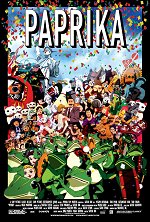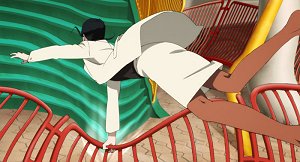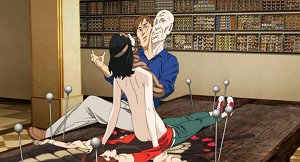 |
|
At The Picture Show
|
August 2007

Sugar and spice
Surreal, nightmarish 'Paprika' proves the power and versatility of animation
Paprika
Sony Pictures Classics
Director: Satoshi Kon
Screenplay: Seishi Minakami and Satoshi Kon, based on the novel by Yasutaka
Tsutsui
Starring: The voices of Megumi Hayashibara, Toru Furuya, Akio Otsuka,
Katsunosuke Hori, Koichi Yamadera, Toru Emori and Daisuke Sakaguchi
Rated R / 1 hour, 30 minutes
Now playing in limited release



 (out of four)
(out of four)
As I mentioned in my Ratatouille review, there is often an assumed, unfair divide
when it comes to animated films. The assumption is made that they are solely for
children, which can lead to a few unfortunate things: 1) certain films ignored by a
large segment of the population, simply because some don't accept the possibility
that an animated movie can be just as enjoyable as anything else; 2) studios
discourage people from even making animated movies for adults, because they
aren't moneymakers; or 3) studios insist on force-feeding our children garbage
like Madagascar, Valiant or Cinderella 3: Gus's Revenge.
 It's too bad, because the list of the best animated
titles of the last several years includes the likes of The Triplets of Belleville, A
Scanner Darkly, just about anything from Miyazaki and, now, Satoshi Kon's
Paprika, a dazzling coming-together of dreamlike imagery and existential
storytelling. In the interest of full disclosure, I'll admit that until Paprika, I hadn't
seen any of Kon's films, so I'm coming at this one with that limited frame of
reference. If his past titles such as Perfect Blue and Tokyo Godfathers are as good
as advertised, I'll most certainly be able to see Paprika on an even clearer, deeper
level.
It's too bad, because the list of the best animated
titles of the last several years includes the likes of The Triplets of Belleville, A
Scanner Darkly, just about anything from Miyazaki and, now, Satoshi Kon's
Paprika, a dazzling coming-together of dreamlike imagery and existential
storytelling. In the interest of full disclosure, I'll admit that until Paprika, I hadn't
seen any of Kon's films, so I'm coming at this one with that limited frame of
reference. If his past titles such as Perfect Blue and Tokyo Godfathers are as good
as advertised, I'll most certainly be able to see Paprika on an even clearer, deeper
level.
But nevermind that for now. Kon has crafted Paprika in a deliberate style that is
absolutely essential to the story he's telling. In fact, it's safe to say this story
couldn't exist without a visual style that not just enhances, but explains. The literal
aspects of the story are images. All kinds of images, through all kinds of filters -
dreams and nightmares, films, photographs, the Internet, art, mirrors,
windows...and even real things, too. In the dreamscape of Paprika, these images
and reality co-exist. Presumably set in the near-future - or otherwise an alternate
version of our present - the film revolves around Dr. Chiba, a scientific researcher
who has been working on an advanced machine (the DC Mini) that gives people
(i.e. trained researchers and therapists) the ability to view and even enter a
patient's subconscious. To experience their dreams. Hopefully for the sake of
helping them.
 The mastermind behind this project is the jovial but
immature Dr. Tokita. He and Chiba work closely with one another and have
proceeded on the project with caution...but obviously not enough, because the
device has been stolen. Now, that might sound bad simply for business
reasons...but it's much worse than that. In the wrong hands, the DC Mini could
wreak havoc. One can enter anyone's mind, confusing the subconscious, blending
the real with the imagined...one could even - quite easily, in fact - completely take
over another person's mind.
The mastermind behind this project is the jovial but
immature Dr. Tokita. He and Chiba work closely with one another and have
proceeded on the project with caution...but obviously not enough, because the
device has been stolen. Now, that might sound bad simply for business
reasons...but it's much worse than that. In the wrong hands, the DC Mini could
wreak havoc. One can enter anyone's mind, confusing the subconscious, blending
the real with the imagined...one could even - quite easily, in fact - completely take
over another person's mind.
Among the first signs of that chaos is a mental breakdown on the part of a Dr.
Shima. He starts spouting nonsense - a grammatically coherent but logically
incomprehensible jumble. He's among his peers and co-workers, but he doesn't
even seem to be present in the same reality as everyone else...and, in fact, he's not.
It's more than a hallucination; he's physically locked in to someone else's dream,
and very nearly gets killed because of it.
Suffice it to say there's a malevolent force or two at work here. It shouldn't be
revealed exactly who is behind all this madness; that is for the viewer to discover
and decipher with the characters. What Kon does so successfully is blend reality
and fantasy into one indeterminable pseudo-reality, or hyper-reality.
 At the very beginning of the film, in a
exceptionally well-made opening scene, there is a very clear line drawn between
what is real and what is not. We experience the recurring dream of an important
character, Detective Toshimi, and then the dream cuts off and we're firmly in
reality, as Toshimi sits with "Paprika" (Chiba's alter-ego, whose off-the-radar
experimentations with the DC Mini come into play), therapeutically discussing
what the dream means and how to deal with it.
At the very beginning of the film, in a
exceptionally well-made opening scene, there is a very clear line drawn between
what is real and what is not. We experience the recurring dream of an important
character, Detective Toshimi, and then the dream cuts off and we're firmly in
reality, as Toshimi sits with "Paprika" (Chiba's alter-ego, whose off-the-radar
experimentations with the DC Mini come into play), therapeutically discussing
what the dream means and how to deal with it.
But from then on, Paprika's footing gets less and less in touch with "reality," as
we interpret it. Imagine vividly experiencing someone else's dream -
involuntarily. When you're not even asleep. That's the nightmare that some -
perhaps everyone - eventually begins to face. And, naturally, there arises the
possibility that no one can control it. That the "reality" these characters know is in
mortal danger. The concept of cerebral terrorism comes into play.
 There are answers, of course. And there are
resolutions. A couple of them are a bit unnecessary, and clog up the plot a bit too
much. Then again, with a film this ambitious, those flaws are easy to forgive. Of
all the movies in recent years that have played with the idea of reality vs. fantasy
(which is which?), none have gone so far as does Paprika. Few, if any, that I've
seen have given that conflict such a physical embodiment. Once the film has
gotten to a certain point, there is literally no actual distinction between reality and
dreams, between conscious and subconscious. And yet somehow, those forces
have to battle it out.
There are answers, of course. And there are
resolutions. A couple of them are a bit unnecessary, and clog up the plot a bit too
much. Then again, with a film this ambitious, those flaws are easy to forgive. Of
all the movies in recent years that have played with the idea of reality vs. fantasy
(which is which?), none have gone so far as does Paprika. Few, if any, that I've
seen have given that conflict such a physical embodiment. Once the film has
gotten to a certain point, there is literally no actual distinction between reality and
dreams, between conscious and subconscious. And yet somehow, those forces
have to battle it out.
If nothing else, Paprika is a fascinating experiment, visually and structurally. If
Kon's past and future work is as good as this, I have a lot to look forward to.
Read more by Chris Bellamy